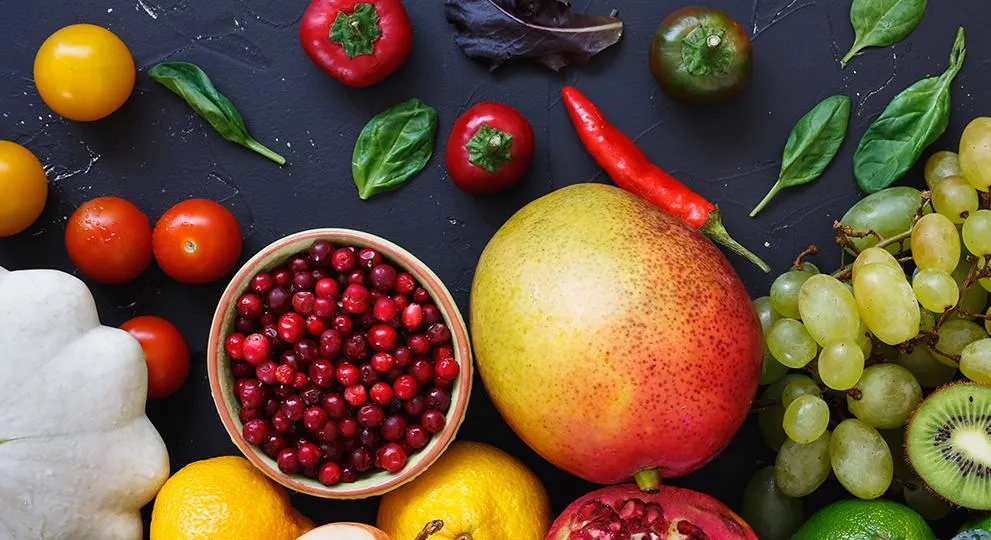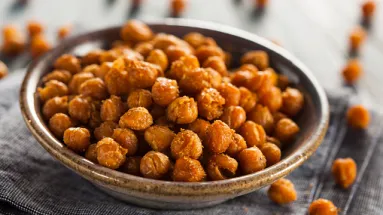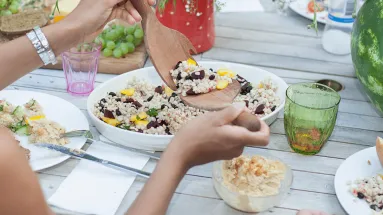Keeping a balanced diet
Keeping a balanced diet

A well-balanced diet includes healthy foods from all food groups. These are protein, grains, fruits and vegetables and healthy fats.
- Protein
Protein provides the building blocks for many parts of our body. These include bones, muscles, skin and blood cells. During cancer treatment, some people require more protein than usual. Eating enough protein can help support healing and strength. Protein is especially important for patients who have lost weight and muscle mass. Healthy sources of protein include lean meat, skinless lean poultry, fish or shellfish, eggs, unsalted nuts and seeds, natural nut butters, beans, peas and legumes. Other non-meat sources include yogurt, cheese and some grains, like quinoa. - Grains
There are 2 categories of grains: refined and whole grains. Refined grains are processed to remove the outer layer, which contains many vitamins and fiber. Whole grains are healthier because the outer layer is kept in place. Eating whole grains provides fiber that may help with constipation. Grains also contain important nutrients. These include B vitamins, folate, iron, magnesium and selenium, which are important vitamins and minerals that help with body functions such as energy production. They also support a healthy nervous system and immune system.
Examples of healthy whole grains include brown rice, wild rice, barley, quinoa, millet, sorghum, bulgur, oats, oatmeal and whole cornmeal, as well as whole-grain bread products, whole-grain pastas and items made from whole-wheat flour. - Fruits and vegetables
One of the most important parts of a healthy diet is eating a variety of fruits and vegetables. Most fruits and vegetables are naturally low in calories and fat. They’re also sources of antioxidants and phytochemicals (plant chemicals, which give fruits and vegetables their vibrant colors). Phytochemicals and antioxidants are helpful to the body. They can lessen damage to cells, decrease inflammation and support immune function. Whole fruits and vegetables are also naturally high in fiber, which adds to their health benefits.
Consider eating fruits and vegetables of a variety of different colors. The green, red, purple, white, orange and yellow colors have different essential nutrients. For example, green vegetables provide a lot of plant-based iron, which helps blood cells carry oxygen; folate, which helps keep red blood cells healthy; and potassium, which can help with blood pressure. Yellow and orange fruits and vegetables provide vitamins A and C, which may help with immune function. - Healthy fats
There are 4 types of fat: saturated fat, trans fat, polyunsaturated fat and monounsaturated fat. Saturated and trans fats are unhealthy fats. They’re often found in processed, fried and high-fat foods. These unhealthy fats are solid at room temperature and include butter, dairy and fatty meats.
Healthy, unsaturated fats are found in vegetables, nuts, seeds, fish and oils that are liquid at room temperature. Sources of healthy fat include olive oil, peanut oil, canola oil, safflower oil and sunflower oil; avocado or avocado oil; fatty fish, such as salmon, mackerel and sardines; and seeds and nuts, such as flaxseeds and walnuts.
Did you know?
Eating well and maintaining a healthy body weight are important throughout your treatment. The potential benefits of good nutrition include lowering your risk of infection and healing and recovering more quickly after treatment.
To best meet your individual needs, your healthcare provider may recommend a special diet based on your cancer symptoms and nutritional requirements.
Making healthy foods into a meal
There are many parts of a healthy diet, but how do they all fit together?
There are many ways to eat healthy. Choose My Plate is one tool created by the United States Department of Agriculture (USDA). This tool helps consumers follow the nutrition advice in the Dietary Guidelines for Americans, a report that’s updated every 5 years.1 Here are some of its recommendations:
- Make half of your plate fruits and vegetables
- Focus on a variety of whole fruits and vegetables rather than canned fruits and juices
- Make half of your grains whole grains
- Choose nonfat or low-fat dairy products
- Choose a variety of lean proteins
- Choose foods and beverages that are low in sodium, saturated fat and added sugars
Visit the choose my plate website for the “daily checklist”
ChooseMyPlate.gov
After you put in a few facts about yourself (age, gender, height, weight and activity level), the DailyChecklist presents a suggested calorie level and daily checklist for healthy eating.2 This checklist includes a daily suggestion of servings from each food group, based on your suggested calorie level. Remember to speak to your healthcare team before making any changes to your diet and to address your individual nutritional needs. There may be some foods your healthcare team will advise you to avoid. This checklist is a helpful tool that patients can use along with the input from their medical team. Your calorie needs may be higher if you have lost weight or are going through treatment.
Making your favorite meals healthier
Do you have a favorite meal that gives you comfort? Even comfort foods can be made healthier. Here are some simple suggestions to add more plant-based foods to your diet.
- Make healthy mac and cheese
Use whole-wheat ziti to make macaroni and cheese. While cooking the ziti, add ½ cup of defrosted frozen spinach to the pot, which will add 1 serving of vegetables. - Try veggie noodles
Cut down your portion of spaghetti by replacing half the recipe with spiralized zucchini noodles (also available pre-made in the frozen or produce aisle). - Include vegetables at breakfast
Sauté mixed vegetables in a pan before cooking your favorite style of eggs. You can use frozen mixed vegetables to save time or chop up ½ to 1 cup of fresh vegetables. - Choose meatless meals
If making a soup or stew, consider leaving out the ham or beef and using beans or lentils and quinoa as the protein source. You can also do this when ordering in a Mexican restaurant, for example, by ordering a beefless burrito with beans. - Make a smoothie
Add 1 cup of baby spinach or baby kale, which mix in easily. This will add 1 serving of vegetables without changing the taste.
Here are some examples of healthy, easy-to-prepare meals for cancer patients:
|
BREAKFAST Oatmeal made with low-fat milk, topped with 1 Tbsp chopped walnuts and 1 sliced orange |
LUNCH Small whole-wheat pita filled with 3 oz canned tuna in water mixed with mustard and ¼ avocado; small side salad |
DINNER 1 cup whole-grain pasta with tomato sauce cooked with 4 oz ground chicken or turkey meat, 1 cup sautéed frozen spinach |
SNACKS Container of nonfat yogurt topped with ½ cup blueberries; 2 cups fresh-popped popcorn; 4 dates topped with 1 tsp natural nut butter each |
Safe food handling
During treatment, it’s important to know about food safety. You may be more likely to develop an infection from any source, including food. This is because your condition and its treatment can weaken your immune system.3 Below are some general guidelines. For more detailed information, visit the Food and Drug Administration’s Food Safety for People with Cancer guide.4
General guidelines: The four basic steps to food safety4
|
1 Clean hands and surfaces often
|
2 Separate raw meat, poultry, fish, seafood, and eggs from ready-to-eat foods |
3 Cook food to a safe internal temperature |
4 Chill perishable foods within 2 hours |
- Food temperature
The safe minimum internal temperatures of cooked food are 145°F for beef, pork, lamb and veal; 160°F for ground meat; and 165°F for poultry.4 - Avoid high risk foods
Be sure to avoid high-risk foods that are more likely to carry bacteria. High-risk foods include raw or undercooked meat, poultry, seafood, or eggs; unpasteurized dairy products (milk or cheese); unwashed fruits or vegetables; cold, uncooked hot dogs and deli meats; and raw sprouts (such as alfalfa, bean, etc).4 - Choose packaged items over items made on-site
When food shopping, choose packaged items over items made on-site. For example, choose a jar of salsa instead of a salsa freshly made in-store, a bottled salad dressing over a house-made one, or a sealed package of almonds versus nuts scooped from a self-serve bulk bin.4
Remember, food safety guidelines are important to follow all of the time: when food shopping, cooking, storing and eating leftovers and eating out. If you’re unsure whether a food is safe to eat, speak to your healthcare provider. If you’re in doubt as to whether a food is spoiled, it’s better to throw it out than eat something that may not be safe.
My nutrition 101 checklist
Use the handy checklist below to stay on track with good nutrition, meal planning, and food safety.
|
Make sure to talk with your healthcare provider prior to making any changes to your diet. |
|
Aim to eat a well-balanced diet of foods from each of the food groups. |
|
Choose healthy sources of protein, grains, fruits, vegetables and healthy fats at each meal. |
|
Make your favorite meals healthier by adding or substituting plant-based foods. |
|
Make food safety a priority. When in doubt, throw it out. |
|
Use reliable resources for food and nutrition information, such as:
|
References:
- Dietary Guidelines: Questions and Answers. Office of Disease Prevention and Health Promotion. https://health.gov/dietaryguidelines/2015/qanda.asp#guidelines-q5. Updated August 10, 2018. Accessed April 15, 2020.
- MyPlate Plan. United States Department of Agriculture. https://www.choosemyplate.gov/resources/MyPlatePlan. Updated June 12, 2018. Accessed April 15, 2020.
- The Immune System and Cancer. Cancer Research UK. https://www.cancerresearchuk.org/about-cancer/what-is-cancer/body-systems-and-cancer/the-immune-system-and-cancer. Published December 15, 2017. Accessed April 15, 2020.
- Food Safety for People with Cancer. U.S. Food and Drug Administration. https://www.fda.gov/food/foodborneillnesscontaminants/peopleatrisk/ucm312565.htm.Published March 12, 2019. Updated June 22, 2018. Accessed April 15, 2020.
This article has general information and is not meant to replace nutritional or health guidance that is specific to any individual. Speak to your healthcare provider before making any changes to your diet or lifestyle. Consult with a registered dietitian if you are on a restricted or modified diet.













